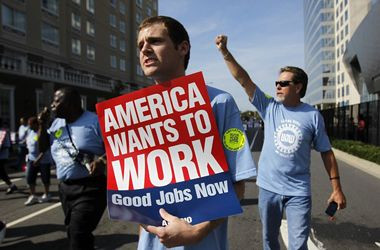August Jobs Report: The Labor Force Participation Rate's Inverse Effect On Falling Unemployment Rate [VIDEO]

Wall Street rebounded in afternoon trading on Friday, after a weaker-than-expected employment report for August and lingering concerns of possible U.S. military strikes in Syria that sent the Dow falling more than 100 points in morning trading.
U.S. stocks tumbled earlier is the session after Russian President Vladimir Putin said he would maintain his military support for Syria if the West were to attack; however, U.S. President Barack Obama calmed market fears over Syria tensions in his latest press conference. Obama and Putin are currently in Russia attending the G-20 summit.
The Labor Department said employment growth in the U.S. was weaker-than-expected in August, with nonfarm payrolls increasing 169,000 in August, compared with expected job gains of 180,000 last month, according to economists polled by Reuters.
The unemployment rate fell to 7.3 percent in August, down from 7.4 percent in July. The latest jobs report comes ahead of the Federal Reserve’s highly anticipated policy meeting on September 17-18, where the FOMC will discuss whether to taper the central bank’s $85 billion-a-month bond-buying program.
“Initially, the numbers that came in today weren’t so horrible, but they were bad enough that led people to believe this might affect tapering come September,” said Jonathan Corpina, senior managing partner with brokerage firm Meridian Equity Partners Inc. from the floor of the New York Stock Exchange.
Corpina explained there was initially not a lot of time for investors to digest the latest employment data because of headlines coming out of the G-20 summit and comments from Putin in relation to Syria, which sent the Dow tumbling more than 100 points earlier in the session.
“Within an instant, we stopped talking and thinking about unemployment data, and we’re wondering what’s coming out of these talks in St. Petersburg,” Corpina said.
Once Obama eased fears over the crisis in Syria, the financial markets once again looked to the jobs report for clues as to when the central bank will begin scaling back its stimulus program.
“Overall, I think this all correlates to how is the Fed going to take this economic data that we see today and other economic indicators that we’ve seen over the month, and how are they going to relate this to tapering in September,” Corpina said.
Earlier this year, Fed chairman Ben Bernanke said the central bank’s bond-buying program would continue until there was “substantial improvement” in the labor market. Then in June, Bernanke hinted once U.S. unemployment reach near 7 percent, the Fed’s asset purchases would come to an end.
“In this scenario when asset purchases ultimately come to an end the unemployment rate would likely be in the vicinity of 7 percent, with solid economic growth supporting further job gains -- a substantial improvement from the 8.1 percent unemployment rate that prevailed when the committee announced this program,” said Bernanke at a press conference in June.
Although the U.S. unemployment rate ticked down to 7.3 percent in August from 7.4 percent in July, the labor force participation rate dropped to 63.2 percent, its worst reading since 1978.
“We’re seeing an inverse relation here. We’re seeing the unemployment rate number go down, and the participation rate, hourly rate not moving in the way they’re supposed to move. It’s kind of tricky and it’s going to be interesting to see how they play this off,” said Corpina. “The information today is really going to add more to that conversation because I don’t think either camp has enough bullets in their chamber to really say there’s enough conviction here that we need to start tapering, or not do it for another month or another quarter. So it’s going to be interesting to see how this market correlates to that and for some reason I think Syria is going to get wrapped into this whole thing.”
July jobs were revised down to 104,000 from 162,000, and 16,000 jobs were also slashed from June's number. The data also revealed hiring over the summer months was largely driven by low-wage, part-time sectors such as retail, food services and health care.
“That’s more of a seasonal thing, more of a short term band-aid number that we use in this unemployment data there,” said Corpina. “I think we need to see it in more sustainable industries where it can last longer.”
With summer ending, investors are getting ready for the holiday season, as retailers such as Wal-Mart, Target and others will start to see numbers tick up in the retail sector.
“Overall, I think we need to find a more sustainable number in certain industries that will help that unemployment number in the long run,” said Corpina.
In afternoon trading on Friday, stocks bounced back headed for a four-day rally as the Dow is on track to hit 15,000 once again.
The Dow Jones industrial average gained 58.06 points, or 0.39 percent, at 14,995.54. The S&P 500 Index rose 8.50 percent, or 0.51 percent, at 1,663.64. The Nasdaq Composite Index was up 16.20 points, or 0.44 percent, at 3,675.04.
© Copyright IBTimes 2024. All rights reserved.




















